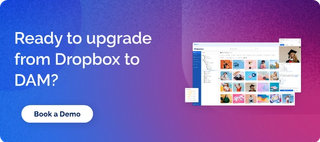In today’s digital-first world, where content creation grows exponentially, organizations find themselves drowning in an ever-expanding sea of digital files. With so many software options out there to help, how can you differentiate between Dropbox and a digital asset management (DAM) system?
When looking for new options and considering how to upgrade their file management systems, many organizations get caught wondering why bother?
According to GrandViewResearch, the global digital content creation market size was valued at USD 32.28 billion in 2024 and is estimated to grow at a CAGR of 13.9% from 2025 to 2030.
This significant growth rate underscores the increasing demand for engaging and visually appealing content and digital assets across various industries, but in order to understand which system your organization should choose, it’s important to compare and contrast. This blog post will cover the differences between Dropbox and DAM.
What is Digital Asset Management (DAM)?
A DAM is a file management system focused on digital media used to store, organize, collaborate on and distribute visual content (photos, videos, graphics, etc.) all from within one central library. Typically focused on brand and marketing-related assets, a DAM is conventionally owned by the marketing team, but can also be used and accessed by many other teams within your organization to maximize productivity.
A DAM offers features that allow users to manage any type of digital file and perform a variety of beneficial functions, including re-sizing and re-formatting their media, tracking usage history, and sharing large files easily.
Additionally, a DAM provides organizations with increased media security, such as user permissions, compliance regulations, and watermarking. Security features are becoming more and more important – your digital assets are an imperative part of your brand and should be protected.
Key Features of a DAM
- Sophisticated Search Capabilities: A DAM makes storing, managing, and finding brand and marketing material (photos, videos, etc.) easy with artificial intelligence, keywords, and advanced search capabilities.
- Permission Settings: Customized access permissions for internal and external users give organizations a tighter rein on digital media. A DAM offers version control, history tracking, and watermarks, as well as enhanced security and compliance.
- Easy Distribution: A DAM includes features that enable easy sharing of large media files, such as high-resolution images, large-format videos, etc., over email, web galleries, or Branded Portals.
- Robust Security Measures: Digital asset management systems such as MediaValet offer top-tier security measures to keep your previous brand assets safe and secure. In fact, MediaValet is the highest-rated DAM vendor, with an A rating from Security Scorecard (99/100).
Why a MediaValet DAM?
MediaValet is not a basic storage solution; it’s a powerhouse for managing, accessing, and sharing a wide range of digital media. MediaValet stands out in the DAM space, especially in security – it’s the top-rated DAM vendor on Security Scorecard. This is particularly relevant in light of Dropbox’s January 2024 data breach, which exposed the vulnerabilities in its security measures.
A MediaValet DAM is best for companies that need a better way to produce, store and distribute large amounts of rich media content (photos, videos, audio, etc.). Even if you are a smaller organization, as you scale, MediaValet can continue to serve you and keep your brand assets safe yet accessible.
Interested in how a MediaValet DAM looks in action? Take our free, self-guided tour here!
What is Dropbox?
Dropbox is one of the most popular online file-sharing services on the market. It provides a web-based library to store, organize and share digital files like PDFs, word documents, images, and videos. Dropbox has a free version with minimal storage, and upgraded, paid packages that scale with storage needs.
Dropbox can be an ideal file storage solution for organizations in their early stages, and has some easy-to-use features that can make it a great foundation for housing and managing smaller file libraries.
It’s worth noting, however, that in January 2024 the mother of all data breaches, as Forbes called it, was reported. These types of security issues are becoming increasingly prevalent; 26 billion leaked records, including Dropbox data, were found in a database highlighting the vulnerabilities and potential risks for growing organizations considering an option that cannot provide true security.
Key Features of Dropbox
- Enhanced Search: Dropbox offers refined search capabilities with file type filtering and advanced sorting.
- Easy Sharing: Dropbox creates shareable links for convenient and easy file sharing. When creating the link, users can choose the permission of the recipient as an editor or viewer of the file, and offers password protection on shareable links.
- Effortless Syncing: Dropbox has a sync folder on the user’s computer that syncs with the cloud. It offers a selective sync functionality that gives users the choice of which folders to sync to their hard drive and which to only sync to the cloud.
Bottom Line
Dropbox is an easy-to-use online file-sharing system that would be a great choice for a small-to-medium organization that has a smaller budget for file storage.
It would not be a fit for organizations actively growing and scaling up their content creation and storage needs, as it would make the price tag increase considerably. It is best for those who don’t need advanced security and user permission settings, but instead, a general hub for storing and sharing files with some basic password protection options.

Why Organizations Choose to Upgrade from Dropbox to DAM
Many organizations begin by using Dropbox or a similar file-sharing system, only to find that as they grow, they need a more robust solution to manage their content—especially their rich media.
However, many organizations find that while an option like Dropbox works for a time, it simply can’t support their growth. With significant issues in security, many companies find that its more beneficial to move from Dropbox to a dedicated DAM system.
The recent Dropbox breach serves as a wake-up call. Organizations that once relied on Dropbox are now turning to DAM systems for enhanced security, scalability, and functionality. A DAM system like MediaValet not only addresses the growing digital asset needs but also provides:

- Previewing: With a DAM, users can preview design files, PDFs, videos, 3D files, large format images, etc. whereas Dropbox has more limited file review capabilities, depending on the file type.
- Asset Rendering and Resizing: A DAM enables users to customize the format and size of each asset when they download or share them. Users no longer need help from the design team, they simply need permission to use the rendering feature.
- Searching: A DAM offers additional advanced search features, including AI auto-tagging, that allow you to find what you’re looking for without the hassle of sifting through a large number of assets.
- Support and Training: A DAM (specifically, MediaValet) offers unlimited onboarding and training, meaning that if you’re ever having challenges or need a refresher, MediaValet will immediately help you, free of charge.
You can learn more about digital asset management pricing options here!
Outgrown Your Digital Storage Needs?
After a closer look at both Dropbox and DAM, it’s clear why many organizations are choosing to upgrade to a digital asset management system. Basic file-sharing systems like Dropbox often serve as a starting point, and as organizations grow, their content creation grows with them—meaning their file storage and sharing needs to scale as well.
Only a DAM can truly scale with a company and meet ongoing needs, not only for storage but for advanced security, search functionality, support, and training. Your digital files need to be safe, easily discoverable when needed, and easily shared. See how MediaValet compares to other DAM vendors in this G2 report.
Related Articles
Ready to see what the DAM hype’s about?
Meet with one of our product experts




